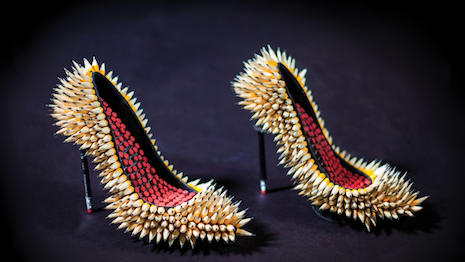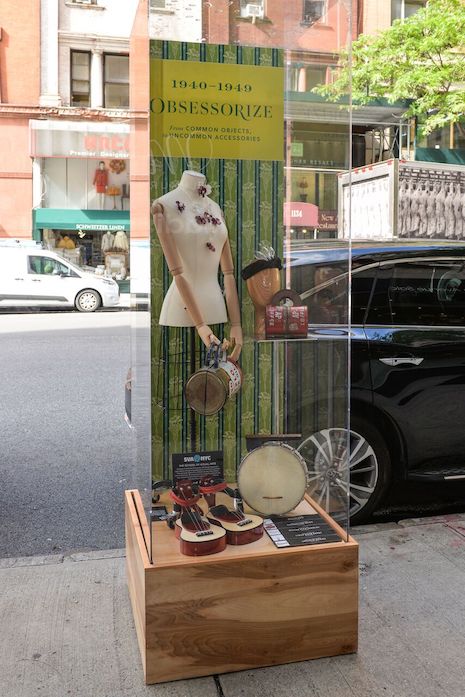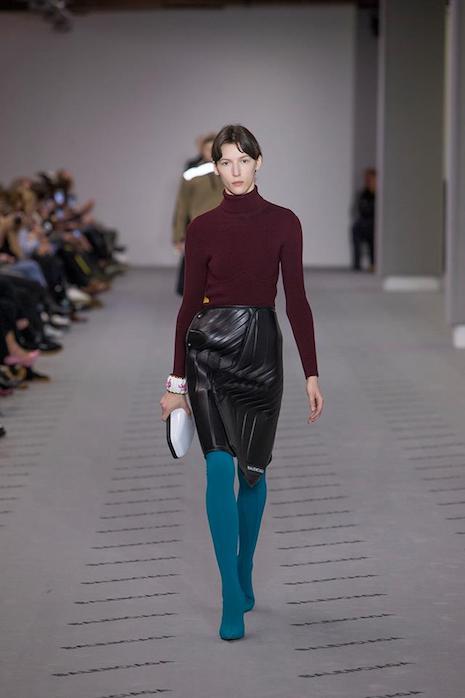 Promotional image for Obsessorize. Image credit: Madison Avenue BID
Promotional image for Obsessorize. Image credit: Madison Avenue BID NEW YORK – Adding a new layer to the overlap between the fashion and art worlds, the Madison Avenue Business Improvement District is bringing an accessories-focused showcase to its high street.
Along with Hearst's Marie Claire and the School of Visual Arts, Madison Avenue BID is presenting “Obsessorize,” a series of installations of fashionable sculptures by the college's students. In a panel discussion on Oct. 9, moderated by Accessories Council president Karen Giberson and hosted by Marie Claire, speakers from Marie Claire and SVA explained the relationship between fashion design and the creation of art.
"Anything you wear every day is an art," said Kevin O’Callaghan, 3D design chairman at School of Visual Arts, New York. "We kind of create our own piece of art in the morning when we wake up and get dressed. We’re all a sculpture of some sort."
Fashion history
Mr. O’Callaghan founded the 3D design program at SVA five years ago. With a background in set design, he has a penchant for found items.
The school’s latest collaboration with the Madison Avenue BID centers on these objects, asking freshmen in the 3D design class to create fashionable art out of everything from Barbies to an old globe.
Students had slightly more than three weeks for the project. They molded shoes, handbags and more, incorporating the items or taking inspiration from them.
Obsessorize display. Image courtesy of Madison Avenue BID
For instance, edible inspirations of bubble tea and Oreo cookies were recreated out of resin for more lasting art.
Mr. O’Callaghan believes that since the students do not have a fashion background, as the school has no fashion program, they were less restricted in what they could think up.
Echoing this, Marie Claire’s accessories director Julia Gall agrees that the fashion industry needs talents with different perspectives. More traditional fashion educations may pigeonhole a designer, whereas creators from outside the industry come from a potentially less encumbered place.
The resulting art for Obsessorize is being featured in eight-foot-tall plexi-glass cases lining Madison Avenue from 57th Street to 86th Street. Each of the displays depicts a particular decade, with pieces set against a background of wallpaper from the time period.
For instance, one centered on the 1980’s includes Chinese takeout shoes and platform sandals made out of the silver astronaut statuettes from the MTV Movie Awards.
Obsessorize display surrounding the 1980s. Image courtesy of Madison Avenue BID
Another case represents the 1960s, with vintage hairdryer pumps and a luggage trolley fashioned out of a dollhouse.
Obsessorize’s often less than wearable designs reflect the way in which consumers are shopping today. Per Ms. Gall, women are currently curating two closets: one with pieces for their day-to-day life and one for special events.
“I think we’re at a pivotal point in fashion and being consumers of fashion where you want to be able to have the exciting and the beautiful and the newness of something, but your day-to-day life requires something different," Ms. Gall said.
"It almost feels like we’re shopping for two separate wardrobes now at this point," she said. "You know what you’re going to be wearing day-to-day but you’re also still a collector and you still appreciate these beautiful things."
Certain special accessories pieces might be put on display in a collector’s home, functioning as art as well as fashion.
Designers are also taking references from objects. For example, Balenciaga’s Demna Gvasalia created teacup-inspired bracelets for a recent runway show.
Look from Balenciaga fall/winter 2017. Image credit: Balenciaga
Wearable art
The art and fashion worlds have been intertwined for decades and luxury brands are able to leverage the high-class market of art to drive business from the overlap of affluent people who love both.
In a new report, Fashionbi took a look at some of the many ways that fashion brands have collaborated with the art world over the years, noting some specific examples that serve as barometers for the relationship between the two. Fashion brands need to be careful in striking a balance between comparing their products to art without overly commercializing the art that people love (see story).
Beyond Obsessorize, Marie Claire has taken an accessories-first approach in other initiatives. For instance, the magazine looked to change the conversation around sunglasses through a partnership with eyewear manufacturer Safilo.
#GetFramed put a spotlight on the accessory category poised for growth, communicating the idea that consumers should have frames to complement each type of outfit and that sunglasses should be bought with each new season along with other wardrobe updates. Creating a link between content and commerce, the program included mobile integration, where consumers could virtually try on and purchase eyewear from Safilo-licensed brands including Dior, Givenchy and Jimmy Choo (see story).
"We believe in accessories," said Nancy Berger, vice president and publisher of Marie Claire, New York. "We love this category so much.
"Karen Giberson is such as good friend of ours as well, because we have that same vision of everybody needs to fill their closets with lots of accessories," she said. "It’s your personal statement. And I think this exhibit brings that to life in such an original way."


